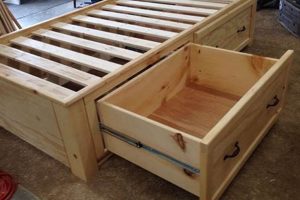Constructing shelving units within a garage setting offers a customizable approach to optimizing spatial efficiency. These structures, often assembled using readily available materials and fundamental tools, address the common challenge of managing clutter and organizing diverse items within a residential storage space. The creation of a tiered system allows for the vertical arrangement of possessions, maximizing usable area within the garage’s footprint.
The implementation of organized shelving provides numerous advantages. Enhanced accessibility to stored items becomes a key benefit, reducing search time and improving overall workflow within the garage. This form of organization contributes to a safer environment by minimizing tripping hazards and preventing potential damage to possessions. Historically, the practice of building personalized storage solutions has reflected a desire for self-sufficiency and a practical approach to home improvement, evolving alongside advancements in construction techniques and material availability.
The subsequent sections will delve into the critical factors influencing the design and construction of these storage solutions, including material selection, structural considerations, and safety protocols. A thorough examination of these elements is essential for ensuring the longevity and effectiveness of the finished installation.
Essential Considerations for Garage Shelving Projects
The following guidance offers critical insights for individuals undertaking the design and construction of shelving systems within a garage environment. Adherence to these recommendations promotes structural integrity, safety, and long-term utility.
Tip 1: Material Selection. Prioritize durable materials such as pressure-treated lumber, plywood of appropriate thickness, or metal shelving components. The chosen materials must withstand anticipated weight loads and environmental conditions within the garage, including temperature fluctuations and potential moisture exposure.
Tip 2: Structural Integrity. Employ robust joinery techniques, such as screws, bolts, or reinforced brackets, to ensure the stability of the shelving unit. Proper framing and bracing are essential to prevent sagging or collapse under heavy loads. Consider the use of diagonal supports to enhance lateral stability.
Tip 3: Load Capacity Assessment. Accurately estimate the maximum weight the shelves will bear. Distribute the load evenly across the shelving surface to prevent localized stress points. Overloading can compromise the structural integrity and lead to potential failure.
Tip 4: Secure Anchoring. Affix the shelving unit securely to the garage wall using appropriate anchors and fasteners. This step is crucial for preventing tipping or movement, particularly with tall or heavily loaded shelves. Verify the wall’s structural capacity before installation.
Tip 5: Vertical Space Optimization. Design shelves with adjustable heights to accommodate items of varying sizes. This maximizes vertical storage capacity and allows for future adjustments as storage needs evolve.
Tip 6: Safety Considerations. Prioritize safety throughout the construction process. Wear appropriate personal protective equipment, including safety glasses and gloves. Ensure the work area is well-ventilated and free of obstructions. Exercise caution when using power tools.
Tip 7: Code Compliance. Research and adhere to local building codes and regulations pertaining to shelving construction and installation. This may include requirements for fire resistance, structural integrity, or accessibility.
By carefully considering these factors, the construction of effective and enduring garage shelving systems becomes a feasible undertaking. Proper planning and execution result in a more organized, functional, and safer storage environment.
These recommendations serve as a foundation for embarking on this project. Further considerations related to specific design choices and aesthetic preferences will be explored in the subsequent conclusion.
1. Material Strength
The structural integrity of constructed garage shelving is directly dependent upon the inherent strength of the materials utilized. Insufficient material strength compromises the load-bearing capacity, leading to potential shelf failure. The selection of wood, metal, or composite materials must align with the anticipated weight and distribution of stored items. A practical example illustrates this principle: shelves constructed from thin, low-density particleboard are unsuitable for storing heavy objects such as automotive parts or paint cans, due to the material’s limited resistance to bending and shear forces. Conversely, shelves fabricated from solid hardwood or reinforced steel offer superior load-bearing capabilities, ensuring long-term stability and preventing structural collapse under significant weight.
Further consideration must be given to environmental factors that can affect material strength over time. Exposure to moisture, temperature fluctuations, and chemical agents can degrade certain materials, reducing their load-bearing capacity. For instance, untreated wood shelving in a damp garage environment may be susceptible to rot and weakening, diminishing its structural integrity. Utilizing pressure-treated lumber or applying protective coatings can mitigate these risks and extend the lifespan of the shelving unit. Similarly, the selection of corrosion-resistant metals is crucial in environments prone to high humidity or exposure to corrosive substances. The proper identification and mitigation of these factors is vital for the enduring safety and effectiveness of the shelving installation.
In summary, the material strength represents a critical determinant of the overall performance and longevity of garage shelving. The selection of materials should be predicated upon a comprehensive assessment of anticipated loads, environmental conditions, and long-term durability requirements. A failure to prioritize material strength can result in structural instability, posing risks to stored items and potentially creating hazardous conditions within the garage environment. Therefore, thorough consideration of this factor is paramount to the successful implementation of a robust and reliable storage solution.
2. Load Distribution
In the context of constructing personalized shelving units for garage organization, load distribution emerges as a critical factor influencing structural integrity and safety. Improper distribution of weight can compromise the shelving system, leading to sagging, instability, or complete structural failure. For instance, concentrating heavy items in the center of a shelf spanning a significant distance without adequate support induces bending stress, potentially exceeding the material’s yield strength. Conversely, evenly distributing the same load across the shelf’s surface reduces stress concentration, minimizing the risk of deformation or collapse. Therefore, the relationship between the weight of stored items and the design of the shelving structure is paramount.
Effective load distribution relies on several key design considerations. Shelf material selection, support placement, and shelf depth are intrinsically linked to the load-bearing capacity. Using a higher-grade lumber or incorporating additional vertical supports can significantly increase the amount of weight a shelf can safely sustain. A practical application involves strategically placing heavy items, such as toolboxes or automotive parts, directly above vertical supports or near the wall anchors. Conversely, lighter items, such as cleaning supplies or gardening tools, can be positioned towards the center of the shelf. This approach minimizes stress on the shelving material and prevents excessive deflection.
Understanding load distribution principles is essential for ensuring the long-term stability and safety of garage shelving systems. Neglecting this aspect can result in costly repairs, potential damage to stored items, and, more seriously, physical harm. By prioritizing even weight distribution, selecting appropriate materials, and strategically placing supports, individuals can construct robust and dependable shelving solutions that effectively address their storage needs while minimizing the risk of structural failure. This proactive approach to garage organization ensures a safer and more efficient workspace.
3. Wall Anchorage
Wall anchorage constitutes a critical component in the safe and effective construction of shelving units within a garage environment. Securely affixing shelves to the structural framework of the garage is paramount for stability, load-bearing capacity, and the prevention of potential accidents.
- Stud Identification and Utilization
Garage walls typically feature vertical studs that provide significant structural support. Locating these studs using a stud finder and anchoring shelves directly into them is essential. Ignoring stud placement and relying solely on drywall anchors can result in shelf failure under moderate to heavy loads. An example of this principle is a shelving unit designed to store heavy automotive fluids; attaching this unit to studs, rather than drywall alone, ensures its long-term stability.
- Appropriate Anchor Selection
The selection of appropriate anchors is contingent upon the wall material and the anticipated load. Concrete walls necessitate the use of concrete anchors, while wood-framed walls require screws of sufficient length and gauge to penetrate deeply into the stud. The incorrect anchor type compromises the connection between the shelf and the wall, potentially leading to a catastrophic collapse. For instance, using drywall screws in concrete will not provide adequate holding power.
- Load Distribution and Anchor Spacing
The number and spacing of wall anchors directly affect the overall load-bearing capacity of the shelving unit. Distributing anchors evenly along the horizontal span of the shelf ensures that the weight is distributed across multiple points of support. Concentrating the load on a single anchor increases the stress on that point, raising the risk of failure. As an example, a long shelf laden with tools requires multiple anchor points spaced appropriately to prevent sagging or detachment from the wall.
- Safety Considerations
Improper wall anchorage poses significant safety risks. Shelves that are not securely attached to the wall can tip over, causing injury or damage to property. Ensuring that shelves are properly anchored reduces the likelihood of such incidents. It is advisable to consult with a qualified professional if there are concerns about the structural integrity of the wall or the selection of appropriate anchoring methods. An illustrative case involves a shelving unit containing flammable liquids; a secure attachment to the wall minimizes the risk of spillage and potential fire hazards.
The connection between the shelving and the wall is fundamental to the overall safety and functionality. Prioritizing wall anchorage through careful stud identification, appropriate anchor selection, strategic load distribution, and adherence to safety protocols ensures the creation of a robust and reliable storage solution. Neglecting this aspect can result in costly repairs, potential damage to stored items, and, more seriously, physical harm.
4. Shelf Dimensions
Shelf dimensions represent a critical design parameter when constructing shelving systems within a garage environment. The careful consideration of height, width, and depth directly impacts storage capacity, accessibility, and overall functionality. Neglecting these factors can lead to inefficient space utilization and compromised storage solutions.
- Height Optimization for Vertical Space
Shelf height significantly impacts the effective use of vertical space within a garage. Shelves designed with adjustable heights accommodate items of varying sizes, maximizing storage capacity. A practical example is implementing shelves with larger vertical spacing to accommodate tall items such as storage bins or tool containers. Conversely, smaller vertical spacing can optimize storage for smaller items like paint cans or cleaning supplies. The appropriate calibration of shelf height directly contributes to a more organized and functional storage system.
- Width Considerations for Accessibility and Support
Shelf width influences accessibility and the structural demands placed on the shelving unit. Wider shelves provide increased storage surface but require greater support to prevent sagging or collapse under load. A real-world application involves designing narrower shelves for storing heavy items to minimize stress on the materials, while wider shelves can accommodate lighter, bulkier objects. Balancing shelf width with appropriate support structures is essential for ensuring the long-term integrity and safety of the shelving system.
- Depth and Organizational Efficiency
Shelf depth impacts organizational efficiency and the ease of retrieving stored items. Deeper shelves maximize storage volume but can make it difficult to access items located at the back. A strategic approach involves tailoring shelf depth to the size and type of stored items. For instance, shallow shelves are ideal for storing frequently used items, facilitating easy access and retrieval. Conversely, deeper shelves can accommodate less frequently accessed items, maximizing overall storage capacity. The appropriate selection of shelf depth optimizes both storage volume and organizational efficiency.
- Relationship to Garage Layout and Traffic Flow
Shelf dimensions must align with the overall garage layout and traffic flow patterns. Shelves that protrude excessively into walkways or impede access to essential equipment can create hazards and hinder functionality. A well-designed shelving system considers the available space and minimizes obstructions. Examples include utilizing corner shelves to maximize space in underutilized areas or implementing shallower shelves in high-traffic zones to ensure unimpeded movement. Thoughtful consideration of these factors results in a safe and efficient storage system that complements the overall garage environment.
These dimensional considerations underscore the importance of meticulous planning when devising shelving. A properly constructed shelving system, with dimensions tailored to the intended storage needs and spatial constraints, yields a safe, organized, and efficient garage environment.
5. Adjustability Options
The incorporation of adjustability features within shelving systems significantly enhances their long-term utility and adaptability to evolving storage requirements within a garage environment. The capacity to modify shelf heights or configurations allows for the accommodation of diverse item sizes and shapes, ensuring optimal space utilization and organizational efficiency.
- Vertical Adjustability for Varied Storage Needs
The ability to alter shelf heights vertically is a fundamental aspect of adjustability. This feature enables the accommodation of items ranging from small tools to large storage containers. Systems employing slotted uprights or adjustable brackets allow for incremental height adjustments, providing flexibility in organizing diverse items. A practical example involves adjusting shelf height to accommodate seasonal items, such as holiday decorations, or oversized tools that require greater vertical clearance. This adaptability ensures the shelving system remains relevant even as storage needs change over time.
- Modular Configuration for Changing Requirements
Modular shelving systems offer the advantage of reconfiguring shelf arrangements to suit evolving storage demands. Individual shelf units can be added, removed, or repositioned to create customized storage solutions. This adaptability is particularly beneficial in garages where storage needs fluctuate frequently. An example of this flexibility is rearranging shelves to accommodate larger equipment or vehicles during certain seasons or projects. The modular design ensures that the shelving system can adapt to changing priorities without requiring complete replacement.
- Adjustable Shelf Depth for Enhanced Accessibility
While less common, the ability to adjust shelf depth can enhance accessibility and organization. Shallower shelves can improve visibility and access to smaller items, while deeper shelves can accommodate larger or less frequently used items. Adjustability in shelf depth can be achieved through sliding shelves or adjustable brackets that allow for repositioning the shelf closer to or further from the wall. An instance of this would be shallow shelves for frequently used tools and deeper shelves above for storage bins. This allows for quick access without needing to rearrange the storage when the shelf is fully loaded.
- Integrated Adjustment Mechanisms for Ease of Use
The design of adjustment mechanisms significantly impacts the ease and frequency with which shelving configurations can be altered. Systems employing simple locking mechanisms or tool-free adjustment features facilitate quick and effortless reconfiguration. The presence of these mechanisms is crucial for encouraging regular adjustments as storage needs evolve. An example is using easily adjustable metal shelves with a click-lock system that does not require tools to change shelf height, versus shelves that need to be unscrewed from their bracing to move.
These adjustment capabilities underscore the significance of incorporating flexibility into shelving designs. By offering a customizable storage environment, individuals can optimize space utilization, enhance organization, and ensure long-term satisfaction with their garage storage solutions. The integration of these features transforms shelving from a static storage structure into a dynamic and adaptable organizational asset.
6. Structural Bracing
Structural bracing is an indispensable element in the design and construction of garage shelving systems. Its primary function is to augment the rigidity and stability of the overall structure, mitigating the risk of deformation or collapse under load. In the absence of adequate bracing, shelving units are susceptible to lateral movement, racking, and eventual failure, particularly when subjected to substantial weight or unevenly distributed loads. The inclusion of bracing is thus a critical factor in ensuring the long-term safety and functionality of a shelf. One can see this in practice with a tall shelving unit; without bracing, there’s a risk for the entire unit to topple over. Adding proper bracing ensures safety in such a case.
Effective structural bracing encompasses various techniques and materials, each designed to counteract specific forces acting upon the shelving unit. Diagonal bracing, typically constructed from wood or metal, resists racking forces by creating triangular support structures within the frame. Back panels, when securely attached to the shelving unit, provide shear strength and prevent lateral movement. Gussets, or triangular reinforcement plates, are commonly employed at joints to enhance their load-bearing capacity. The selection and implementation of appropriate bracing methods depend upon factors such as shelf dimensions, anticipated load, and the inherent strength of the materials used. A real-world example is the incorporation of a plywood back panel to the shelf construction ensures that load distribution is even, removing strain on any specific point of the shelf and reducing the possibility of failure.
In summary, the integration of robust structural bracing is non-negotiable in the creation of durable and safe garage shelving. The absence of proper bracing compromises structural integrity, posing risks to stored items and potentially endangering individuals within the garage environment. A well-braced shelf not only extends the lifespan of the shelving unit but also contributes to a safer and more organized storage space. Prioritizing structural bracing is therefore paramount to the successful implementation of a functional and reliable storage solution.
7. Safety Protocols
The construction of personalized shelving solutions for garage storage necessitates strict adherence to safety protocols. A failure to implement and maintain these protocols introduces substantial risk, potentially resulting in physical harm, property damage, or structural instability. These protocols encompass a broad spectrum of considerations, from personal protective equipment to safe tool operation and structural integrity assessments. The absence of such protocols correlates directly with an elevated risk of accidents and compromised structural performance. For instance, neglecting to wear safety glasses while cutting lumber exposes the individual to projectile debris, increasing the risk of eye injury. Similarly, operating power tools without proper training heightens the probability of user error and subsequent injury.
The practical application of safety protocols extends beyond personal well-being to encompass the structural integrity of the shelving itself. The use of appropriate fasteners, load-bearing assessments, and secure wall anchorage are integral to preventing shelf collapse or failure. A real-world example illustrates this point: a shelving unit constructed without proper wall anchorage poses a significant tipping hazard, particularly when loaded with heavy items. This scenario highlights the importance of rigorous adherence to established construction standards and safety guidelines. Further, awareness of load limits helps reduce the chances of overloading and subsequent collapse.
In summation, safety protocols are not merely ancillary considerations but rather integral components of successful and secure garage shelving construction. A diligent commitment to these protocols mitigates risks, protects individuals, and ensures the long-term stability and functionality of storage solutions. A comprehensive understanding and proactive implementation of safety measures are essential prerequisites for any undertaking of garage shelving construction.
Frequently Asked Questions
The following addresses common inquiries regarding the planning, construction, and maintenance of shelving installations within garage environments. Information provided aims to clarify key considerations for ensuring safety and optimizing storage solutions.
Question 1: What constitutes the most appropriate material for constructing garage shelving, considering varying environmental conditions?
Material selection depends on anticipated load and environmental factors. Pressure-treated lumber offers resistance to moisture, while steel provides superior strength for heavy items. Composite materials offer a balance of durability and cost-effectiveness. Assess anticipated use and garage conditions prior to selection.
Question 2: How can structural integrity be ensured when building extended shelving units?
Long spans require intermediate supports. Vertical supports should be positioned at regular intervals, determined by the shelf material and anticipated load. Diagonal bracing provides additional lateral stability, preventing racking and potential collapse.
Question 3: What are the recommended methods for securely anchoring shelving units to garage walls?
Shelves should be anchored directly to wall studs using appropriate fasteners. Stud finders aid in locating studs accurately. When studs are inaccessible, heavy-duty drywall anchors or toggle bolts offer alternative solutions, though load capacity is reduced.
Question 4: What factors should be considered when determining optimal shelf depth?
Shelf depth should align with the size of anticipated stored items. Deeper shelves maximize storage volume but can hinder accessibility. Shallower shelves facilitate easier item retrieval. Balancing depth with accessibility is essential for efficient organization.
Question 5: How can adjustability be incorporated into shelving designs to accommodate evolving storage needs?
Slotted uprights and adjustable brackets provide flexible shelf height adjustments. Modular shelving systems offer the ability to reconfigure entire shelf arrangements. Prioritize systems with easy-to-use adjustment mechanisms for convenient reconfiguration.
Question 6: What safety precautions are essential during shelving construction and use?
Wear appropriate personal protective equipment, including safety glasses and gloves. Ensure the work area is well-ventilated. Avoid overloading shelves beyond their rated capacity. Regularly inspect shelving for signs of damage or instability.
These answers provide a foundational understanding of garage shelving considerations. Careful planning and execution are paramount for creating safe and effective storage solutions.
The following conclusion section summarizes the key takeaways and offers final recommendations for garage shelving endeavors.
Concluding Remarks on Garage Shelving Solutions
This exploration of garage shelving construction has underscored the criticality of several interconnected factors. Material selection, structural integrity, secure anchorage, and judicious dimensional planning emerge as essential elements for creating functional and enduring storage systems. Adherence to established safety protocols further ensures the well-being of individuals during construction and subsequent use. Consideration of adjustability enhances the long-term utility and adaptability of these installations.
The construction of shelving systems represents a significant investment in garage organization and safety. A rigorous commitment to these principles transforms a space fraught with potential hazards into a structured and efficient environment. Diligence in planning and execution remains paramount for achieving optimal outcomes and realizing the full benefits of a well-designed storage solution.







